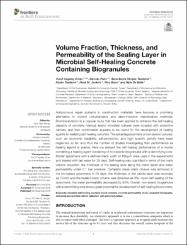| dc.contributor.author | Erşan, Yusuf Çagatay | |
| dc.contributor.author | Palin, Damian | |
| dc.contributor.author | Yengec Tasdemir, Sena Busra | |
| dc.contributor.author | Taşdemir, Kasím | |
| dc.contributor.author | Jonkers, Henk Marius | |
| dc.contributor.author | Boon, Nico | |
| dc.contributor.author | de Belie, Nele D. | |
| dc.date.accessioned | 2020-02-24T06:19:14Z | |
| dc.date.available | 2020-02-24T06:19:14Z | |
| dc.date.issued | 2018 | en_US |
| dc.identifier.issn | 22973362 | |
| dc.identifier.other | DOI: 10.3389/fbuil.2018.00070 | |
| dc.identifier.uri | https://hdl.handle.net/20.500.12573/189 | |
| dc.description | The authors wish to thank Arjan Thijssen for his guidance during the acquisition of the X-ray computed µCT images. The research leading to these results has been funded through the European Union Seventh Framework Programme (FP7/2007–2013) under grant agreement no 290308—SheMat. | en_US |
| dc.description.abstract | Autonomous repair systems in construction materials have become a promising alternative to current unsustainable and labor-intensive maintenance methods. Biomineralization is a popular route that has been applied to enhance the self-healing capacity of concrete. Various axenic microbial cultures were coupled with protective carriers, and their combination appears to be useful for the development of healing agents for realizing self-healing concrete. The advantageous traits of non-axenic cultures, such as economic feasibility, self-protection, and high specific activity have been neglected so far, and thus the number of studies investigating their performance as healing agents is scarce. Here we present the self-healing performance of a mortar containing a healing agent consisting of non-axenic biogranules with a denitrifying core. Mortar specimens with a defined crack width of 400 µm were used in the experiments and treated with tap water for 28 days. Self-healing was quantified in terms of the crack volume reduction, the thickness of the sealing layer along the crack depth and water permeability under 0.1 bar pressure. Complete visual crack closure was achieved in the bio-based specimens in 28 days, the thickness of the calcite layer was recorded as 10 mm and the healed crack volume was detected as 6%. Upon self-sealing of the specimens, the water permeability decreased by 83%. Overall, non-axenic biogranules with a denitrifying core shows great potential for development of self-healing bioconcrete. © 2018 Ersan, Palin, Yengec Tasdemir, Tasdemir, Jonkers, Boon and De Belie. | en_US |
| dc.description.sponsorship | 290308—SheMat | en_US |
| dc.language.iso | eng | en_US |
| dc.publisher | Frontiers Media S.A. | en_US |
| dc.relation.ispartofseries | Volume 4; | |
| dc.rights | info:eu-repo/semantics/openAccess | en_US |
| dc.subject | Bacteria-based concrete | en_US |
| dc.subject | Carbonate precipitation | en_US |
| dc.subject | Concrete permeability | en_US |
| dc.subject | Microbial self-healing | en_US |
| dc.subject | Nitrate reduction | en_US |
| dc.subject | Self-protected culture | en_US |
| dc.subject | X-ray computed tomography | en_US |
| dc.title | Volume fraction, thickness, and permeability of the sealing layer in microbial self-healing concrete containing biogranules | en_US |
| dc.type | article | en_US |
| dc.contributor.department | AGÜ, Mühendislik Fakültesi, İnşaat Mühendisliği Bölümü | en_US |
| dc.contributor.institutionauthor | | |
| dc.identifier.doi | 10.3389/fbuil.2018.00070 | |
| dc.relation.publicationcategory | Makale - Uluslararası Hakemli Dergi - Kurum Öğretim Elemanı | en_US |


















